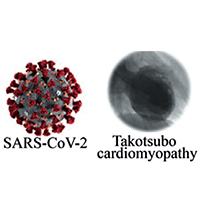A review of the presentation and outcome of Takotsubo cardiomyopathy in COVID-19

All claims expressed in this article are solely those of the authors and do not necessarily represent those of their affiliated organizations, or those of the publisher, the editors and the reviewers. Any product that may be evaluated in this article or claim that may be made by its manufacturer is not guaranteed or endorsed by the publisher.
Accepted: 23 January 2021
Authors
Although the most frequent presentation of the novel Coronavirus disease-2019 (COVID-19) is a respiratory syndrome, cardiac involvement is being increasingly recognized. One such entity is Takotsubo cardiomyopathy. We sought to review the various cases of Takotsubo cardiomyopathy reported during the COVID-19 pandemic and consolidate the information available on its clinical features, evaluation and treatment. We performed a PubMed search using the MeSH terms “Takotsubo Cardiomyopathy” or “Stress Cardiomyopathy” and “COVID-19”, and identified 16 case reports, two case series, and one retrospective cohort study. There was a total of 24 reported patients with COVID-19 infection, who developed takotsubo cardiomyopathy, and two patients without COVID-19 who developed takotsubo cardiomyopathy due to the emotional stress associated with the global pandemic. The mean age of the patients was 67.19 years (SD 15.83) and 16(59.3%) were women. Chest pain was reported in only ten patients (38.46 %) and ST-elevation was seen in 11 patients (42.3%). While most patients had typical takotsubo cardiomyopathy, four patients had inverted(reverse) takotsubo cardiomyopathy, two had bi-ventricular involvement, one had median Takotsubo and another had global Takotsubo with apical sparing variant. Most patients had a positive outcome with complete or near-complete reversal of cardiac dysfunction at the time of discharge. Five deaths (19.23%) were reported. Takotsubo cardiomyopathy is a rare, but increasingly reported reversible cardiomyopathy that can be seen in patients with COVID-19 infection and the diagnosis must be actively sought for in these patients.
How to Cite

This work is licensed under a Creative Commons Attribution-NonCommercial 4.0 International License.






